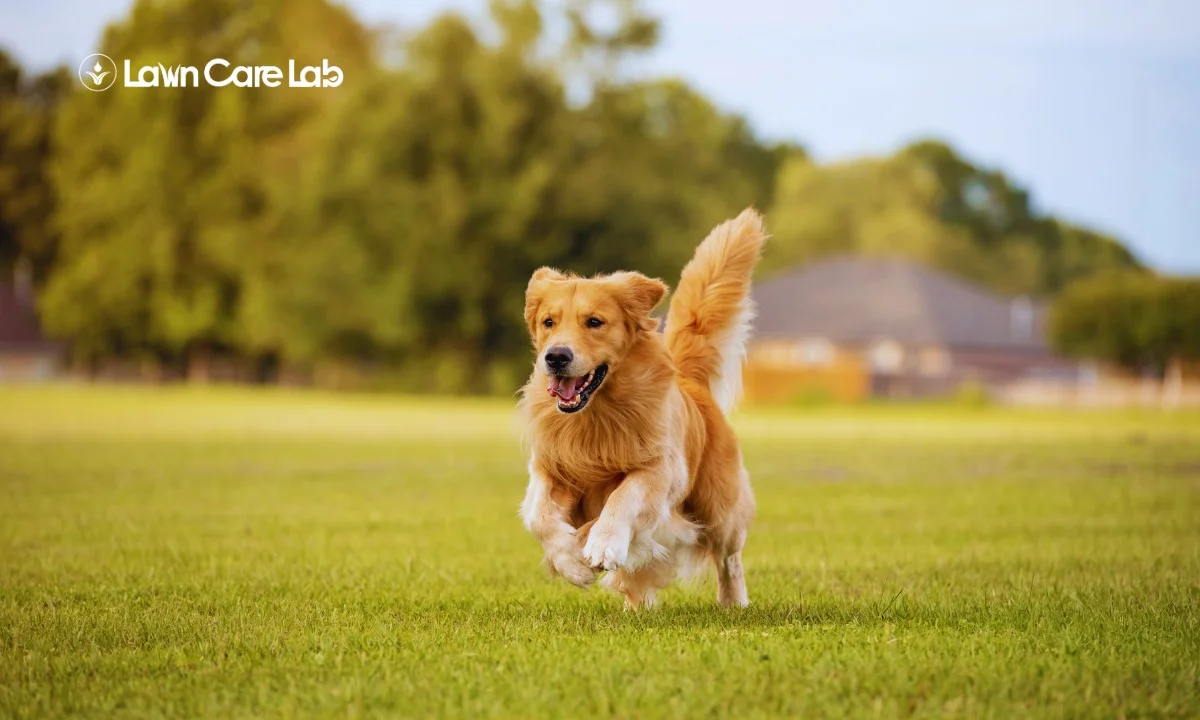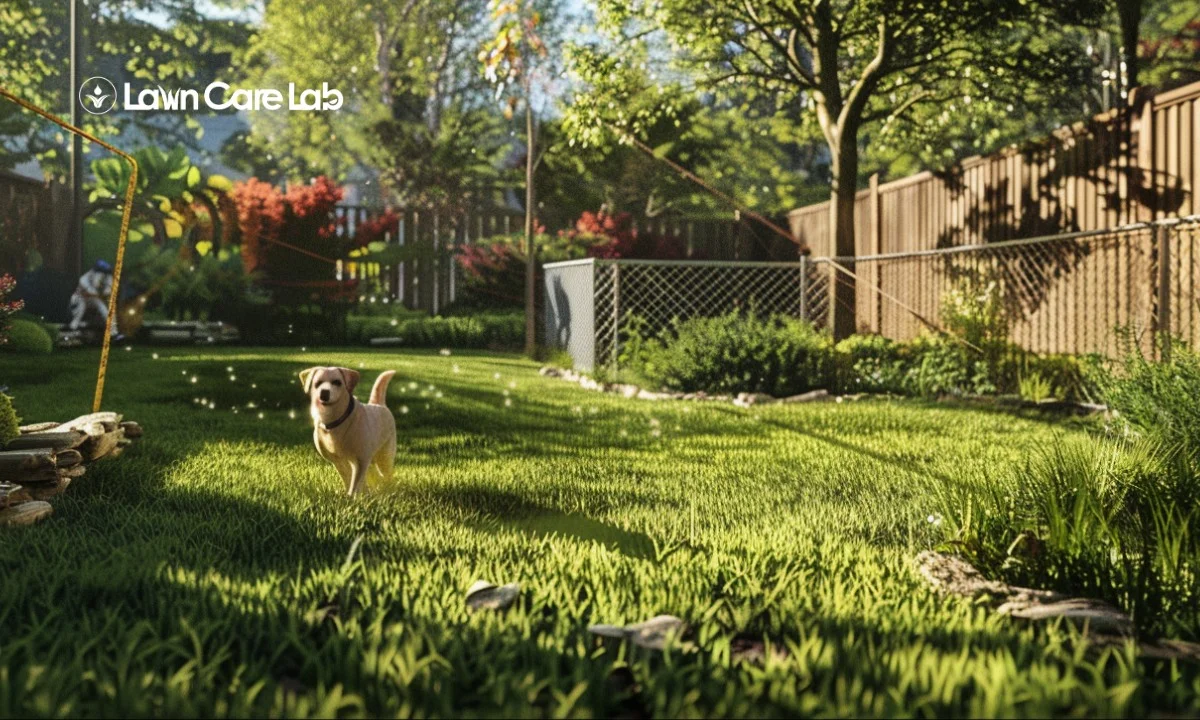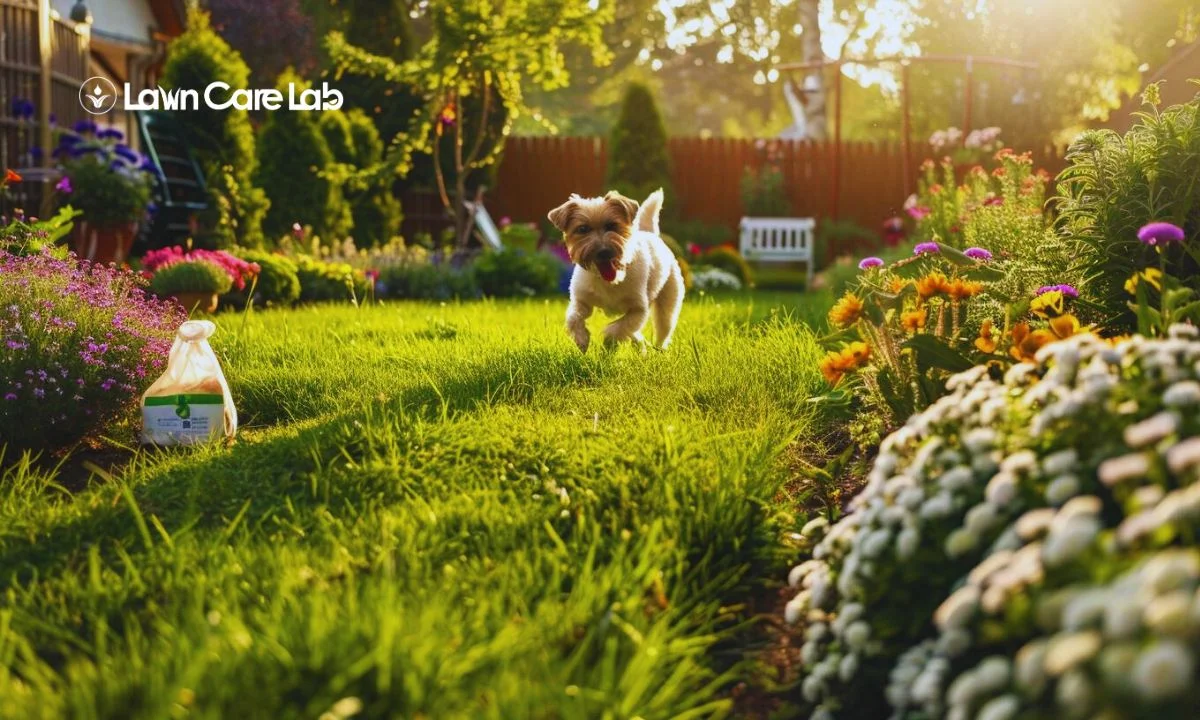You’re the proud owner of a stunning emerald lawn, yet you’re concerned about your beloved Rover wreaking havoc on its beauty. Worry not! We’re here to help.
Learn how to keep your yard lush and safe for your furry friend. Discover dog-friendly grass seeds, ideal sod types, and tactics for managing high-traffic areas.
You’ll gain insights on maintaining your yard’s verdant charm while ensuring your dog’s contentment.
Table of Contents
Choosing Grass Seeds for a Dog-Friendly Yard

Choosing the right grass seed is crucial for creating a dog-friendly yard. Opt for a variety that can withstand constant activity to maintain vitality and visual appeal.
When choosing grass for your lawn, look for varieties that recover quickly and resist concentrated nitrogen from dog urine for a lush, robust, and pet-friendly yard.
Consider Fescues and Perennial Ryegrass for a durable, pet-friendly lawn that resists discoloration and damage from dog urine.
The Basics of Grass Growing With Dogs

Cultivating grass with dogs requires preparation and consistent care. Balance a verdant yard with a secure, engaging environment for your pet.
Preparing Your Yard for Grass Planting
To ensure optimal growth of your pet-friendly grass, start by testing your yard’s soil health. Aim for a pH level between 6.0 and 7.0. Add lime to rectify acidity and sulfur to increase it if needed.
Choose the right grass for your dog based on its activity level, climate, and yard sunlight. Some grass varieties can handle pet activity better than others.
Prepare the soil by tilling it for seeding. Your dog will love the green turf.
Maintaining Grass Health Amidst Dog Activities
Maintaining a healthy lawn that accommodates your pet’s outdoor activities is possible with proper irrigation, fertilization, and trimming. So, make a schedule for these.
Furthermore, designate specific yard sections for your dog’s activities to ensure safety and prevent damage.
Rest assured, a picturesque lawn and a contented canine are mutually attainable with meticulous attention to detail.
Discovering Dog-Safe Grass Seed Options
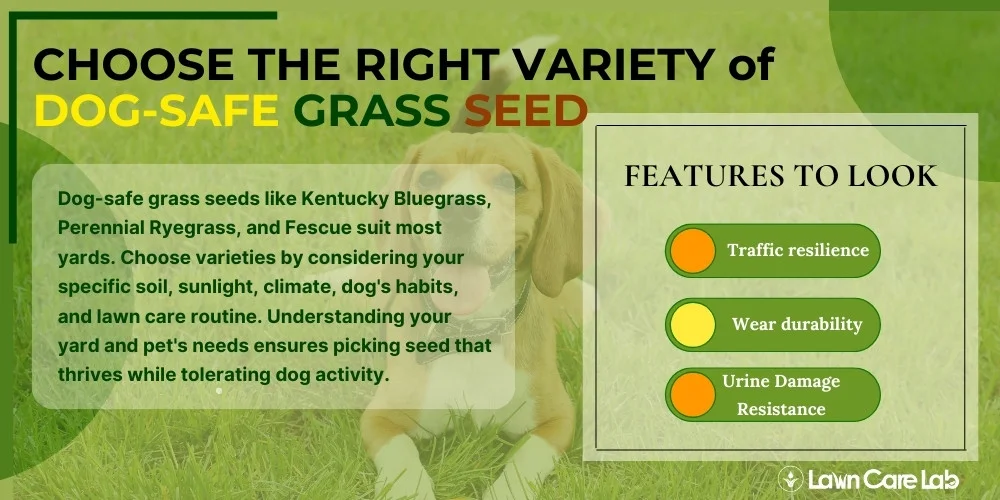
We’ll explore pet-friendly landscaping options that offer both beauty and safety.
Features to Look for in Dog-Safe Grass Seeds
Ensure your dog-safe grass seeds are durable, wear-resistant, and urine-resistant for a vibrant lawn that keeps your pet safe.
Consider these three primary attributes in canine-friendly grass seeds:
- Traffic resilience: Choose durable seeds for high foot and paw traffic so your dog can play without damaging the lawn.
- Wear durability: Consider seeds that can withstand wear and tear. This guarantees a robust and healthy lawn, irrespective of your dog’s playful antics.
- Urine Damage Resistance: Dogs, by nature, will inevitably urinate on the grass. Choosing seeds that can weather urine damage will help sustain a vibrant, lush lawn.
Choose the Top-Rated Dog Safe Grass Seed Varieties
Safe grass seed varieties for dogs include Kentucky Bluegrass, Perennial Ryegrass, and Fescue grasses.
Selecting the right one depends on:
- The specifics of your yard: the nature of the soil, amount of sunlight, and prevalent weather conditions.
- Your dog’s habits: whether it likes to run, dig, or relax in the yard.
- Your preferred care routine: the frequency of watering and mowing.
Ensure optimal grass seed selection by tailoring to yard and pet needs.
Unveiling the Best Sod for Dogs
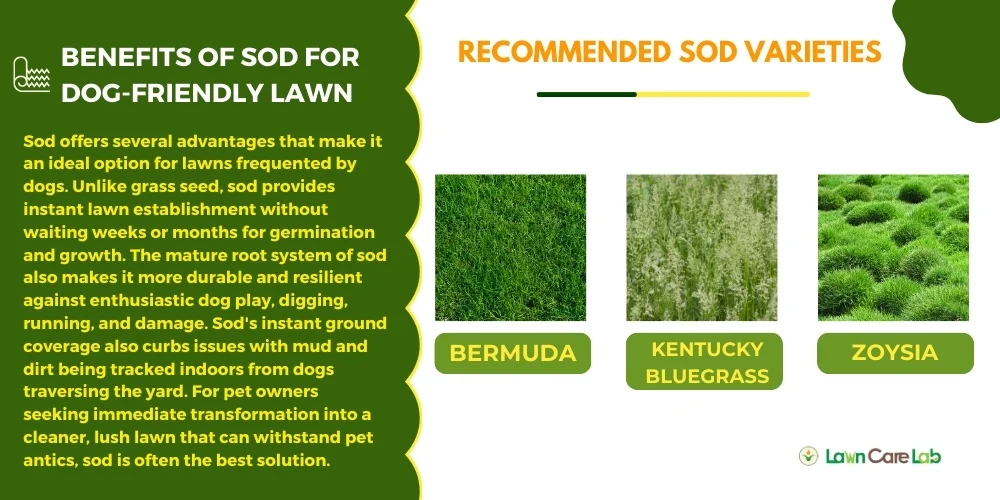
Sod offers immediate lawn establishment, durability for pet play, and cleaner yards – advantages for dog owners.
Recommended Sod Varieties for Dogs
Among the hardiest sod choices, Bermuda grass, Kentucky Bluegrass, and Zoysia grass stand out as ideal for withstanding your pet’s exuberant frolics.
Bermuda grass, a sun-lover, quickly rejuvenates itself from wear and tear, making it ideal for boisterous play sessions.
Kentucky Bluegrass has a deep root system, tolerates cold weather, and recovers quickly from damage.
Zoysia grass is rugged and versatile, thriving in hot, dry, and partially shaded areas, making it great for various yards.
Each of these sod varieties promises a verdant and safe playground for your dog’s unending amusement.
An Insight into Dog-Resistant Grass
Consider dog-resistant grass for a preserved lawn and a safe habitat for your furry friend. This grass is engineered to withstand canine activities while maintaining a vibrant appearance.
Benefits of Dog-Resistant Grass Varieties
Here are three salient benefits that dog-resistant grass offers:
- Tenacity: This grass can endure high traffic and wear, regardless of your dog’s playful nature.
- Resilience: It possesses remarkable recuperative abilities from damage, ensuring your lawn remains immaculate.
- Urine tolerance: The grass is structured to withstand the effects of dog urine, a prevalent instigator of lawn damage.
Popular Dog Resistant Grass Options
The premier selections are Bermuda grass, Zoysia grass, and Kentucky Bluegrass. Each of these grass varieties boasts its unique attributes.
| Grass Species | Principal Attribute |
|---|---|
| Bermuda Grass | Exceptional resilience, withstands wear and tear |
| Zoysia Grass | Adaptable to diverse soil conditions, resists heavy traffic |
| Kentucky Bluegrass | Rapid recovery, ideally suited for cool climates |
Consider local weather, sunlight, and soil type when selecting dog-resistant grass for optimal growth and a secure environment for your dog.
Strategies for Growing Grass in High-Traffic Dog Areas
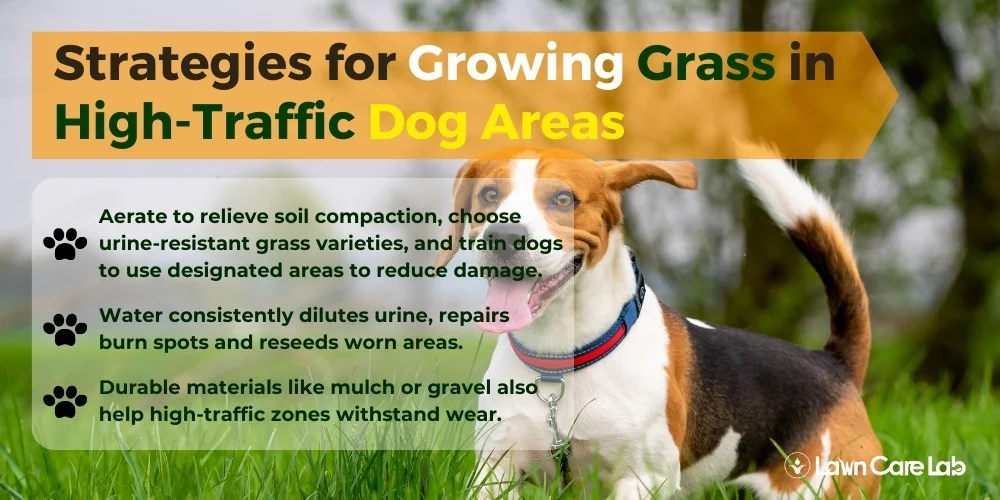
Managing high-traffic areas frequented by dogs is the next issue to address.
Challenges in High-Traffic Dog Areas
It’s crucial to understand the challenges of high-density canine areas: soil compaction, urine damage, and constant wear from furry friends’ activities.
- Soil Compaction: Grassroots struggle to access nutrients and water due to soil conditions, like a constricted chest.
- Urine Damage: Dog urine’s nitrogen content can scorch grass, causing brown patches like bleach to spill on rugs. Increased salt content can discolor the grass to yellow or brown, ultimately causing it to die.
- Physical Wear and Tear: Frequent running and playing can damage grass, like shoes wear out over time.
Tips for Grass Growth in These Areas
Aeration reduces soil compaction and helps your lawn’s roots absorb nutrients better.
Consistent watering is paramount to neutralize canine urine and avert burn spots.
Choose foot traffic and urine-resistant grass varieties like Kentucky Bluegrass or Fescue for reseeding.
Create a dog run with durable materials like mulch or gravel.
Train dogs to use less visible areas and drink more water to avoid lawn damage from urine. Dilute accidents with water and use grass repair treatments.
Let’s now conclude by discussing constructing a flourishing, canine-friendly yard.
Conclusion: Creating a Dog-Friendly Yard That Thrives
Transform your yard into a haven for your furry companion. Manage high-traffic areas and opt for durable grass types to prevent damage caused by dog urine. Use proper hydration, aeration, and dog-safe fertilizers for a healthy lawn.
Create a dog-friendly yard with safety and enjoyment in mind. Empower yourself with the right strategies for a lush, healthy space.
Frequently Asked Questions
What Are the Potential Dangers of Non-Dog-Friendly Grass Seeds?
Are There Any Specific Dog Breeds That May Be More Sensitive to Certain Types of Grass?
How Can I Protect My Dog From Ingesting Grass Seeds?
Besides Grass, What Are Other Safe Plants to Have in a Dog-Friendly Yard?
Can I Use Fertilizers or Pesticides on My Dog-Friendly Grass Without Jeopardizing My Dog’s Health?
- How to Create a Lawn Care Schedule for Southern Climates - October 30, 2024
- How to Use Compost Tea to Boost Lawn Growth and Soil Health - October 23, 2024
- The Best Grasses for Saltwater-Exposed Lawns: Coastal Lawn Care - October 17, 2024

